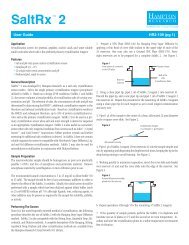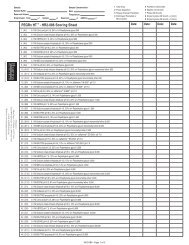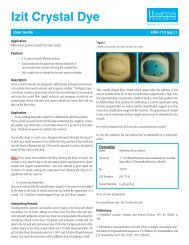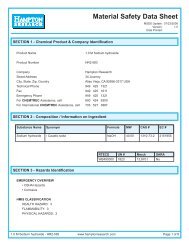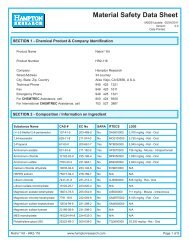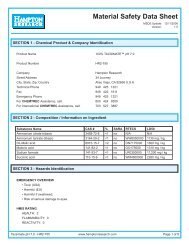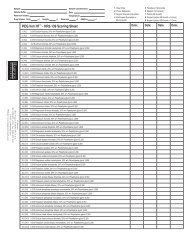Additive Screen User Guide/Formulation/Scoring - Hampton Research
Additive Screen User Guide/Formulation/Scoring - Hampton Research
Additive Screen User Guide/Formulation/Scoring - Hampton Research
- No tags were found...
Create successful ePaper yourself
Turn your PDF publications into a flip-book with our unique Google optimized e-Paper software.
<strong>Additive</strong> <strong>Screen</strong>TMSolutions for Crystal Growth<strong>User</strong> <strong>Guide</strong> HR2-428 (pg 2)Figure 1Typical observations in acrystallization experimentClear DropSkin/PrecipitatePrecipitate4Examine The DropCarefully examine the drops under a stereo microscope(10 to 100x magnification) immediatelyafter setting up the screen. Record all observationsand be particularly careful to scan the focal planefor small crystals. Observe the drops once eachday for the first week, then once a week there after.Records should indicate whether the drop is clear,contains precipitate, and or crystals. It is helpful todescribe the drop contents using descriptive terms.Adding magnitude is also helpful. Example: 4+yellow/brown fine precipitate, 2+ small bipyramidcrystals, clear drop, 3+ needle shaped crystalsin 1+ white precipitate. One may also employ astandard numerical scoring scheme (Clear = 0,Precipitate = 1, Crystal = 10, etc). Figure 1 (leftside of page 2) shows typical examples of what onemight observe in a crystallization experiment.Precipitate/PhaseQuasi CrystalsMicrocrystalsNeedle ClusterPlates5References and Readings1. Crystallization of membrane proteins. Edited byHartmut Michel, CRC Press, 1991.2. Crystallization of nucleic acids and proteins, Editedby A. Ducruix and R. Giege, The Practical ApproachSeries, Oxford Univ. Press, 1992 175-191.3. <strong>Screen</strong>ing and optimization strategies for macromolecularcrystal growth. Cudney, B. et al, ActaCryst. (1994). D50, 414-423.4. Use of glycerol, polyols and other protein structurestabilizing agents in protein crystallization.R. Sousa. Acta Cryst. (1995) D51, 271-277.5. Influence of divalent cations on protein crystallization.Trakhanov, S. and Quiocho, F.A. (1995)Protein Science 4(9): 1914-1919.6. Non-detergent sulphobetaines: a new class ofmild solubilizing agents for protein purification. L.Vuillard, C. Braun-Breton, T. Rabilloud, Biochem.J. (1995) 305, 337-343.7. A new additive for protein crystallization. L. Vuillard,T. Rabilloud, R. Leberman, C. Berthet-Colominas,St. Cusack. FEBS Letters, 353 (1994) 294-296.Technical SupportInquiries regarding <strong>Additive</strong> <strong>Screen</strong> reagent formulation,interpretation of screen results, optimizationstrategies and general inquiries regardingcrystallization are welcome. Please e-mail, fax,or telephone your request to <strong>Hampton</strong> <strong>Research</strong>.Fax and e-mail Technical Support are available 24hours a day. Telephone technical support is available8:00 a.m. to 5:00 p.m. USA Pacific StandardTime.Rod ClusterSingle Crystal
<strong>Additive</strong> <strong>Screen</strong> HR2-428 Reagent <strong>Formulation</strong>Tube#SaltTube#ClassificationTube#Suggested Drop Concentration1. (A1) 0.1 M Barium chloride dihydrate2. (A2) 0.1 M Cadmium chloride hydrate3. (A3) 0.1 M Calcium chloride dihydrate4. (A4) 0.1 M Cobalt(II) chloride hexahydrate5. (A5) 0.1 M Copper(II) chloride dihydrate6. (A6) 0.1 M Magnesium chloride hexahydrate7. (A7) 0.1 M Manganese(II) chloride tetrahydrate8. (A8) 0.1 M Strontium chloride hexahydrate9. (A9) 0.1 M Yttrium(III) chloride hexahydrate10. (A10) 0.1 M Zinc chloride11. (A11) 0.1 M Iron(III) chloride hexahydrate12. (A12) 0.1 M Nickel(II) chloride hexahydrate13. (B1) 0.1 M Chromium(III) chloride hexahydrate14. (B2) 0.1 M Praseodymium(III) acetate hydrate15. (B3) 1.0 M Ammonium sulfate16. (B4) 1.0 M Potassium chloride17. (B5) 1.0 M Lithium chloride18. (B6) 2.0 M Sodium chloride19. (B7) 0.5 M Sodium fluoride20. (B8) 1.0 M Sodium iodide21. (B9) 2.0 M Sodium thiocyanate22. (B10) 1.0 M Potassium sodium tartrate tetrahydrate23. (B11) 1.0 M Sodium citrate tribasic dihydrate24. (B12) 1.0 M Cesium chloride25. (C1) 1.0 M Sodium malonate pH 7.026. (C2) 0.1 M L-Proline27. (C3) 0.1 M Phenol28. (C4) 30% v/v Dimethyl sulfoxide29. (C5) 0.1 M Sodium bromide30. (C6) 30% w/v 6-Aminohexanoic acid31. (C7) 30% w/v 1,5-Diaminopentane dihydrochloride32. (C8) 30% w/v 1,6-Diaminohexane33. (C9) 30% w/v 1,8-Diaminooctane34. (C10) 1.0 M Glycine35. (C11) 0.3 M Glycyl-glycyl-glycine36. (C12) 0.1 M Taurine37. (D1) 0.1 M Betaine hydrochloride38. (D2) 0.1 M Spermidine39. (D3) 0.1 M Spermine tetrahydrochloride40. (D4) 0.1 M Hexammine cobalt(III) chloride41. (D5) 0.1 M Sarcosine42. (D6) 0.1 M Trimethylamine hydrochloride43. (D7) 1.0 M Guanidine hydrochloride44. (D8) 0.1 M Urea45. (D9) 0.1 M b-Nicotinamide adenine dinucleotide hydrate46. (D10) 0.1 M Adenosine-5’-triphosphate disodium salt hydrate47. (D11) 0.1 M TCEP hydrochloride48. (D12) 0.01 M GSH (L-Glutathione reduced),0.01 M GSSG (L-Glutathione oxidized)1. (A1) Multivalent2. (A2) Multivalent3. (A3) Multivalent4. (A4) Multivalent5. (A5) Multivalent6. (A6) Multivalent7. (A7) Multivalent8. (A8) Multivalent9. (A9) Multivalent10. (A10) Multivalent11. (A11) Multivalent12. (A12) Multivalent13. (B1) Multivalent14. (B2) Multivalent15. (B3) Salt16. (B4) Salt17. (B5) Salt18. (B6) Salt19. (B7) Salt20. (B8) Salt21. (B9) Salt22. (B10) Salt23. (B11) Salt24. (B12) Salt25. (C1) Salt26. (C2) Amino Acid27. (C3) Dissociating Agent28. (C4) Dissociating Agent29. (C5) Dissociating Agent30. (C6) Linker31. (C7) Linker32. (C8) Linker33. (C9) Linker34. (C10) Linker35. (C11) Linker36. (C12) Linker37. (D1) Linker38. (D2) Polyamine39. (D3) Polyamine40. (D4) Polyamine41. (D5) Polyamine / Osmolyte42. (D6) Chaotrope43. (D7) Chaotrope44. (D8) Chaotrope45. (D9) Co-factor46. (D10) Co-factor47. (D11) Reducing Agent48. (D12) Reducing Agent1. (A1) 0.01 M (10 mM)2. (A2) 0.01 M (10 mM)3. (A3) 0.01 M (10 mM)4. (A4) 0.01 M (10 mM)5. (A5) 0.01 M (10 mM)6. (A6) 0.01 M (10 mM)7. (A7) 0.01 M (10 mM)8. (A8) 0.01 M (10 mM)9. (A9) 0.01 M (10 mM)10. (A10) 0.01 M (10 mM)11. (A11) 0.01 M (10 mM)12. (A12) 0.01 M (10 mM)13. (B1) 0.01 M (10 mM)14. (B2) 0.01 M (10 mM)15. (B3) 0.1 M (100 mM)16. (B4) 0.1 M (100 mM)17. (B5) 0.1 M (100 mM)18. (B6) 0.2 M (200 mM)19. (B7) 0.05 M (50 mM)20. (B8) 0.1 M (100 mM)21. (B9) 0.2 M (200 mM)22. (B10) 0.1 M (100 mM)23. (B11) 0.1 M (100 mM)24. (B12) 0.1 M (100 mM)25. (C1) 0.1 M (100 mM)26. (C2) 0.01 M (10 mM)27. (C3) 0.01 M (10 mM)28. (C4) 3.0%29. (C5) 0.01 M (10 mM)30. (C6) 3.0%31. (C7) 3.0%32. (C8) 3.0%33. (C9) 3.0%34. (C10) 0.1 M (100 mM)35. (C11) 0.03 M (30 mM)36. (C12) 0.01 M (10 mM)37. (D1) 0.01 M (10 mM)38. (D2) 0.01 M (10 mM)39. (D3) 0.01 M (10 mM)40. (D4) 0.01 M (10 mM)41. (D5) 0.01 M (10 mM)42. (D6) 0.01 M (10 mM)43. (D7) 0.1 M (100 mM)44. (D8) 0.01 M (10 mM)45. (D9) 0.01 M (10 mM)46. (D10) 0.01 M (10 mM)47. (D11) 0.01 M (10 mM)48. (D12) 0.001 M (1 mM)<strong>Additive</strong> <strong>Screen</strong> contains ninety-six unique reagents beginning at position A1.To determine the formulation of each reagent, simply read across the page.Solutions for Crystal Growth
<strong>Additive</strong> <strong>Screen</strong> HR2-428 Reagent <strong>Formulation</strong>Tube#SaltTube#ClassificationTube#Suggested Drop Concentration49. (E1) 0.1 M Ethylenediaminetetraacetic acid disodium salt dihydrate50. (E2) 5% w/v Polyvinylpyrrolidone K1551. (E3) 30% w/v Dextran sulfate sodium salt (M r 5,000)52. (E4) 40% v/v Pentaerythritol ethoxylate (3/4 EO/OH)53. (E5) 10% w/v Polyethylene glycol 3,35054. (E6) 30% w/v D-(+)-Glucose monohydrate55. (E7) 30% w/v Sucrose56. (E8) 30% w/v Xylitol57. (E9) 30% w/v D-Sorbitol58. (E10) 12% w/v myo-Inositol59. (E11) 30% w/v D-(+)-Trehalose dihydrate60. (E12) 30% w/v D-(+)-Galactose61. (F1) 30% v/v Ethylene glycol62. (F2) 30% v/v Glycerol63. (F3) 3.0 M NDSB-19564. (F4) 2.0 M NDSB-20165. (F5) 2.0 M NDSB-21166. (F6) 2.0 M NDSB-22167. (F7) 1.0 M NDSB-25668. (F8) 0.15 mM CYMAL ® -769. (F9) 20% w/v Benzamidine hydrochloride70. (F10) 5% w/v n-dodecyl-N,N-dimethylamine-N-oxide, (LDAO, DDAO)71. (F11) 5% w/v n-Octyl-b-D-glucoside72. (F12) 5% w/v n-Dodecyl-b-D-maltoside73. (G1) 30% w/v Trimethylamine N-oxide dihydrate74. (G2) 30% w/v 1,6-Hexanediol75. (G3) 30% v/v (+/-)-2-Methyl-2,4-pentanediol76. (G4) 50% v/v Polyethylene glycol 40077. (G5) 50% v/v Jeffamine ® M-600 ® pH 7.078. (G6) 40% v/v 2,5-Hexanediol (mixture of isomers)79. (G7) 40% v/v (±)-1,3-Butanediol80. (G8) 40% v/v Polypropylene glycol P 40081. (G9) 30% v/v 1,4-Dioxane82. (G10) 30% v/v Ethanol83. (G11) 30% v/v 2-Propanol84. (G12) 30% v/v Methanol85. (H1) 10% v/v 1,2-Butanediol86. (H2) 40% v/v tert-Butanol87. (H3) 40% v/v 1,3-Propanediol88. (H4) 40% v/v Acetonitrile89. (H5) 40% v/v Formamide90. (H6) 40% v/v 1-Propanol91. (H7) 5% v/v Ethyl acetate92. (H8) 40% v/v Acetone93. (H9) 0.25% v/v Dichloromethane94. (H10) 7% v/v 1-Butanol95. (H11) 40% v/v 2,2,2-Trifluoroethanol96. (H12) 40% v/v 1,1,1,3,3,3-Hexafluoro-2-propanol49. (E1) Chelating Agent50. (E2) Polymer51. (E3) Polymer52. (E4) Polymer53. (E5) Polymer54. (E6) Carbohydrate55. (E7) Carbohydrate56. (E8) Carbohydrate57. (E9) Carbohydrate58. (E10) Carbohydrate59. (E11) Carbohydrate60. (E12) Carbohydrate61. (F1) Polyol62. (F2) Polyol63. (F3) Non-detergent64. (F4) Non-detergent65. (F5) Non-detergent66. (F6) Non-detergent67. (F7) Non-detergent68. (F8) Amphiphile69. (F9) Amphiphile70. (F10) Detergent71. (F11) Detergent72. (F12) Detergent73. (G1) Osmolyte74. (G2) Organic, Non-volatile75. (G3) Organic, Non-volatile76. (G4) Organic, Non-volatile77. (G5) Organic, Non-volatile78. (G6) Organic, Non-volatile79. (G7) Organic, Non-volatile80. (G8) Organic, Non-volatile81. (G9) Organic, Volatile82. (G10) Organic, Volatile83. (G11) Organic, Volatile84. (G12) Organic, Volatile85. (H1) Organic, Volatile86. (H2) Organic, Volatile87. (H3) Organic, Volatile88. (H4) Organic, Volatile89. (H5) Organic, Volatile90. (H6) Organic, Volatile91. (H7) Organic, Volatile92. (H8) Organic, Volatile93. (H9) Organic, Volatile94. (H10) Organic, Volatile95. (H11) Organic, Volatile96. (H12) Organic, Volatile49. (E1) 0.01 M (10 mM)50. (E2) 0.5%51. (E3) 3.0%52. (E4) 4.0%53. (E5) 1.0%54. (E6) 3.0%55. (E7) 3.0%56. (E8) 3.0%57. (E9) 3.0%58. (E10) 1.2%59. (E11) 3.0%60. (E12) 3.0%61. (F1) 3.0%62. (F2) 3.0%63. (F3) 0.3 M (300 mM)64. (F4) 0.2 M (200 mM)65. (F5) 0.2 M (200 mM)66. (F6) 0.2 M (200 mM)67. (F7) 0.1 M (200 mM)68. (F8) 0.000015 M (0.015 mM)69. (F9) 2.0%70. (F10) 0.5%71. (F11) 0.5%72. (F12) 0.5%73. (G1) 3.0%74. (G2) 3.0%75. (G3) 3.0%76. (G4) 5.0%77. (G5) 5.0%78. (G6) 4.0%79. (G7) 4.0%80. (G8) 4.0%81. (G9) 3.0%82. (G10) 3.0%83. (G11) 3.0%84. (G12) 3.0%85. (H1) 1.0%86. (H2) 4.0%87. (H3) 4.0%88. (H4) 4.0%89. (H5) 4.0%90. (H6) 4.0%91. (H7) 0.5%92. (H8) 4.0%93. (H9) 0.025%94. (H10) 0.7%95. (H11) 4.0%96. (H12) 4.0%<strong>Additive</strong> <strong>Screen</strong> contains ninety-six unique reagents beginning at position A1.To determine the formulation of each reagent, simply read across the page.Solutions for Crystal Growth
Sample:Sample Concentration:Sample Buffer:Reservoir Volume:Date:Temperature:Drop Volume: Total ml Sample ml Reservoir ml <strong>Additive</strong> ml1 Clear Drop2 Phase Separation3 Regular Granular Precipitate4 Birefringent Precipitate orMicrocrystals5 Posettes or Spherulites6 Needles (1D Growth)7 Plates (2D Growth)8 Single Crystals (3D Growth < 0.2 mm)9 Single Crystals (3D Growth > 0.2 mm)<strong>Additive</strong> <strong>Screen</strong> - HR2-428 <strong>Scoring</strong> Sheet Date: Date: Date: Date:1. (A1) 0.1 M Barium chloride dihydrate Multivalent2. (A2) 0.1 M Cadmium chloride hydrate Multivalent3. (A3) 0.1 M Calcium chloride dihydrate Multivalent4. (A4) 0.1 M Cobalt(II) chloride hexahydrate Multivalent5. (A5) 0.1 M Copper(II) chloride dihydrate Multivalent6. (A6) 0.1 M Magnesium chloride hexahydrate Multivalent7. (A7) 0.1 M Manganese(II) chloride tetrahydrate Multivalent8. (A8) 0.1 M Strontium chloride hexahydrate Multivalent9. (A9) 0.1 M Yttrium(III) chloride hexahydrate Multivalent10. (A10) 0.1 M Zinc chloride Multivalent11. (A11) 0.1 M Iron(III) chloride hexahydrate Multivalent12. (A12) 0.1 M Nickel(II) chloride hexahydrate Multivalent13. (B1) 0.1 M Chromium(III) chloride hexahydrate Multivalent14. (B2) 0.1 M Praseodymium(III) acetate hydrate Multivalent15. (B3) 1.0 M Ammonium sulfate Salt16. (B4) 1.0 M Potassium chloride Salt17. (B5) 1.0 M Lithium chloride Salt18. (B6) 2.0 M Sodium chloride Salt19. (B7) 0.5 M Sodium fluoride Salt20. (B8) 1.0 M Sodium iodide Salt21. (B9) 2.0 M Sodium thiocyanate Salt22. (B10) 1.0 M Potassium sodium tartrate tetrahydrate Salt23. (B11) 1.0 M Sodium citrate tribasic dihydrate Salt24. (B12) 1.0 M Cesium chloride Salt25. (C1) 1.0 M Sodium malonate pH 7.0 Salt26. (C2) 0.1 M L-Proline Amino Acid27. (C3) 0.1 M Phenol Dissociating Agent28. (C4) 30% v/v Dimethyl sulfoxide Dissociating Agent29. (C5) 0.1 M Sodium bromide Dissociating Agent30. (C6) 30% w/v 6-Aminohexanoic acid Linker31. (C7) 30% w/v 1,5-Diaminopentane dihydrochloride Linker32. (C8) 30% w/v 1,6-Diaminohexane Linker33. (C9) 30% w/v 1,8-Diaminooctane Linker34. (C10) 1.0 M Glycine Linker35. (C11) 0.3 M Glycyl-glycyl-glycine Linker36. (C12) 0.1 M Taurine Linker37. (D1) 0.1 M Betaine hydrochloride Linker38. (D2) 0.1 M Spermidine Polyamine39. (D3) 0.1 M Spermine tetrahydrochloride Polyamine40. (D4) 0.1 M Hexammine cobalt(III) chloride Polyamine41. (D5) 0.1 M Sarcosine Polyamine/Osmolyte42. (D6) 0.1 M Trimethylamine hydrochloride Chaotrope43. (D7) 1.0 M Guanidine hydrochloride Chaotrope44. (D8) 0.1 M Urea Chaotrope45. (D9) 0.1 M b-Nicotinamide adenine dinucleotide hydrate Co-factor46. (D10) 0.1 M Adenosine-5’-triphosphate disodium salt hydrate Co-factor47. (D11) 0.1 M TCEP hydrochloride Reducing agent48. (D12) 0.01 M GSH (L-Glutathione reduced), Reducing agent0.01 M GSSG (L-Glutathione oxidized)
Sample:Sample Concentration:Sample Buffer:Reservoir Volume:Date:Temperature:Drop Volume: Total ml Sample ml Reservoir ml <strong>Additive</strong> ml1 Clear Drop2 Phase Separation3 Regular Granular Precipitate4 Birefringent Precipitate orMicrocrystals5 Posettes or Spherulites6 Needles (1D Growth)7 Plates (2D Growth)8 Single Crystals (3D Growth < 0.2 mm)9 Single Crystals (3D Growth > 0.2 mm)<strong>Additive</strong> <strong>Screen</strong> - HR2-428 <strong>Scoring</strong> Sheet Date: Date: Date: Date:49. (E1) 0.1 M Ethylenediaminetetraacetic acid disodium salt dihydrate Chelating Agent50. (E2) 5% w/v Polyvinylpyrrolidone K15 Polymer51. (E3) 30% w/v Dextran sulfate sodium salt (Mr 5,000) Polymer52. (E4) 40% v/v Pentaerythritol ethoxylate (3/4 EO/OH) Polymer53. (E5) 10% w/v Polyethylene glycol 3,350 Polymer54. (E6) 30% w/v D-(+)-Glucose monohydrate Carbohydrate55. (E7) 30% w/v Sucrose Carbohydrate56. (E8) 30% w/v Xylitol Carbohydrate57. (E9) 30% w/v D-Sorbitol Carbohydrate58. (E10) 12% w/v myo-Inositol Carbohydrate59. (E11) 30% w/v D-(+)-Trehalose dihydrate Carbohydrate60. (E12) 30% w/v D-(+)-Galactose Carbohydrate61. (F1) 30% v/v Ethylene glycol Polyol62. (F2) 30% v/v Glycerol Polyol63. (F3) 3.0 M NDSB-195 Non-detergent64. (F4) 2.0 M NDSB-201 Non-detergent65. (F5) 2.0 M NDSB-211 Non-detergent66. (F6) 2.0 M NDSB-221 Non-detergent67. (F7) 1.0 M NDSB-256 Non-detergent68. (F8) 0.15 mM CYMAL ® -7 Amphiphile69. (F9) 20% w/v Benzamidine hydrochloride Amphiphile70. (F10) 5% w/v n-dodecyl-N,N-dimethylamine-N-oxide, (LDAO, DDAO) Detergent71. (F11) 5% w/v n-Octyl-b-D-glucoside Detergent72. (F12) 5% w/v n-Dodecyl-b-D-maltoside Detergent73. (G1) 30% w/v Trimethylamine N-oxide dihydrate Osmolyte74. (G2) 30% w/v 1,6-Hexanediol Organic, Non-volatile75. (G3) 30% v/v (+/-)-2-Methyl-2,4-pentanediol Organic, Non-volatile76. (G4) 50% v/v Polyethylene glycol 400 Organic, Non-volatile77. (G5) 50% v/v Jeffamine ® M-600 ® pH 7.0 Organic, Non-volatile78. (G6) 40% v/v 2,5-Hexanediol Organic, Non-volatile79. (G7) 40% v/v (±)-1,3-Butanediol Organic, Non-volatile80. (G8) 40% v/v Polypropylene glycol P 400 Organic, Non-volatile81. (G9) 30% v/v 1,4-Dioxane Organic, Volatile82. (G10) 30% v/v Ethanol Organic, Volatile83. (G11) 30% v/v 2-Propanol Organic, Volatile84. (G12) 30% v/v Methanol Organic, Volatile85. (H1) 10% v/v 1,2-Butanediol Organic, Volatile86. (H2) 40% v/v tert-Butanol Organic, Volatile87. (H3) 40% v/v 1,3-Propanediol Organic, Volatile88. (H4) 40% v/v Acetonitrile Organic, Volatile89. (H5) 40% v/v Formamide Organic, Volatile90. (H6) 40% v/v 1-Propanol Organic, Volatile91. (H7) 5% v/v Ethyl acetate Organic, Volatile92. (H8) 40% v/v Acetone Organic, Volatile93. (H9) 0.25% v/v Dichloromethane Organic, Volatile94. (H10) 7% v/v 1-Butanol Organic, Volatile95. (H11) 40% v/v 2,2,2-Trifluoroethanol Organic, Volatile96. (H12) 40% v/v 1,1,1,3,3,3-Hexafluoro-2-propanol Organic, Volatile



